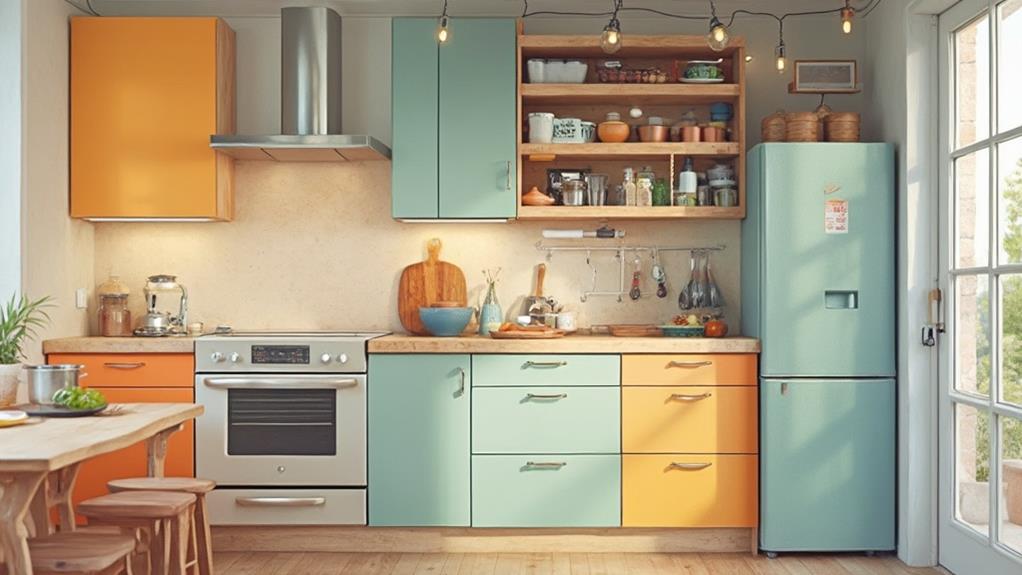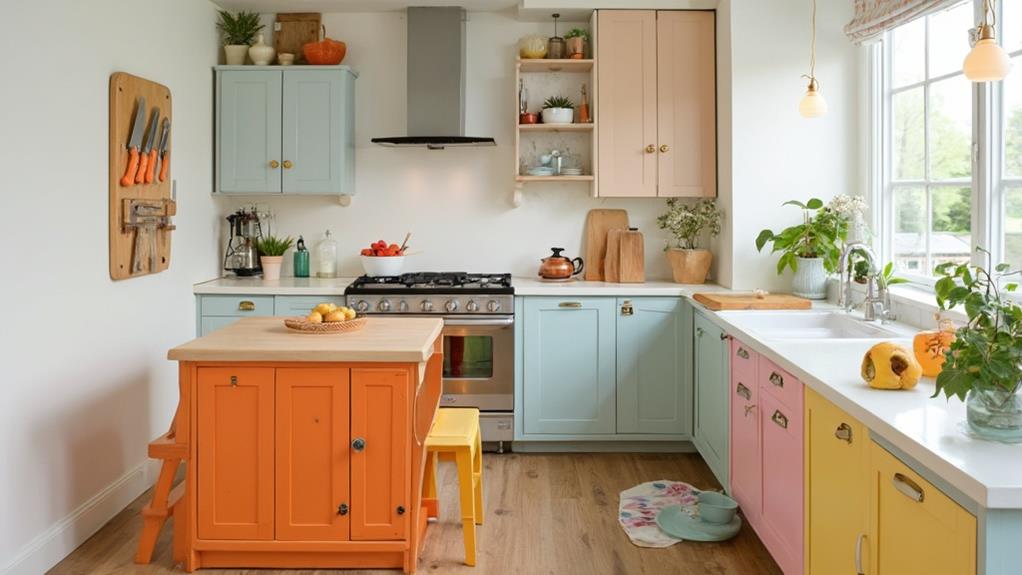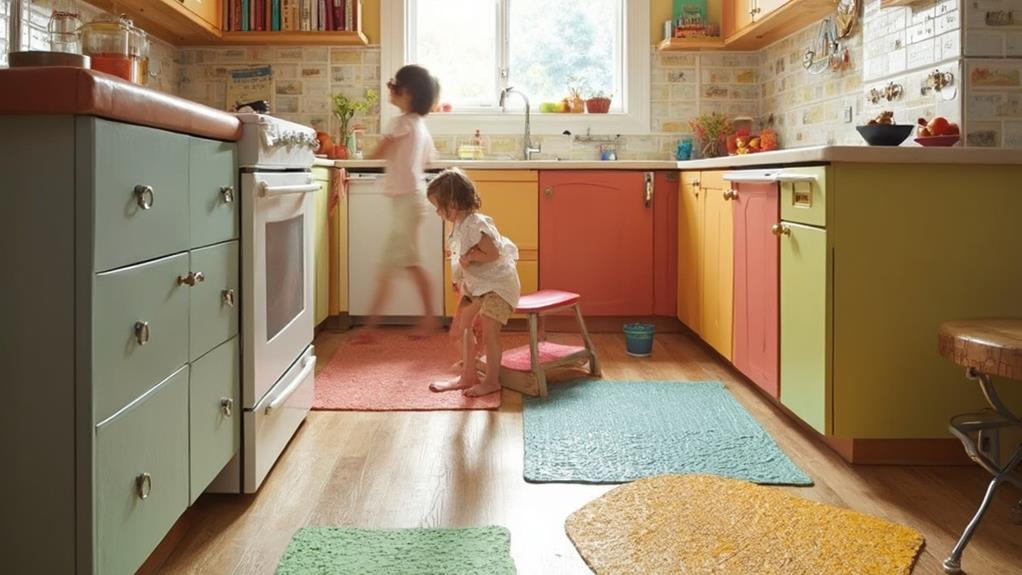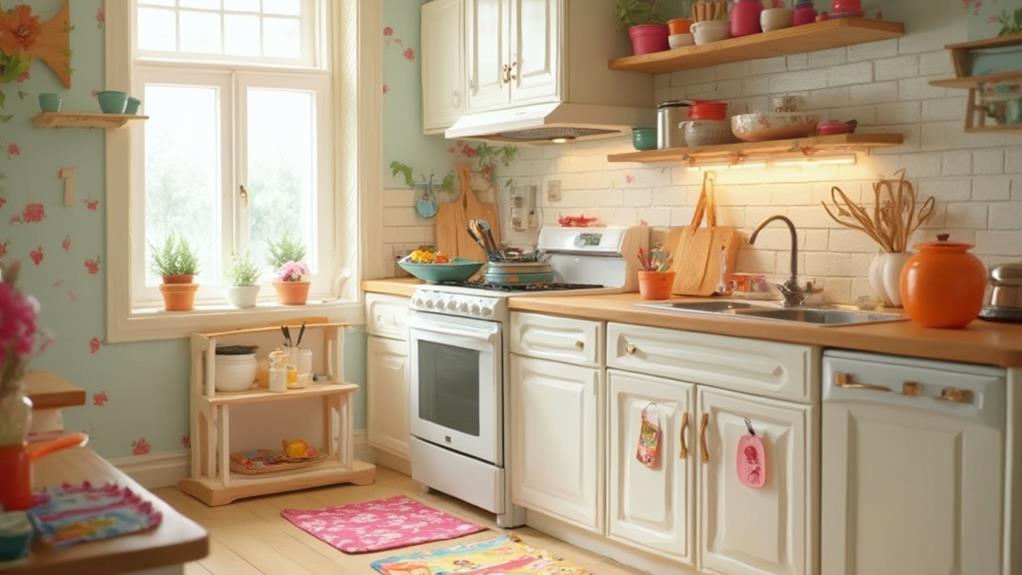When designing a kid-friendly kitchen, focus on both safety and functionality. Install lower cabinets with child locks for hazardous items, and use open shelving at child-height to encourage independence. Place ovens and microwaves at higher levels, and choose cooktops with controls at the back or sides. Create a designated low-height work area with child-sized utensils and a step stool. Opt for rounded edges on countertops and tables to prevent injuries. Choose non-slip flooring options like cork or textured vinyl for added safety. By incorporating these elements, you'll create a space that's safe, accessible, and nurturing for your little chef's culinary adventures. Discover more ways to make your kitchen a family-friendly haven.
Smart Storage Solutions

When designing a kid-friendly kitchen, smart storage solutions are essential for keeping the space organized and safe. Start by installing lower cabinets with child locks to store potentially hazardous items like cleaning supplies and sharp utensils. Use pull-out drawers and lazy Susans to make items easily accessible for adults while keeping them out of children's reach.
Consider adding open shelving at a lower height for kids to access their own dishes, cups, and snacks. This fosters independence and reduces the risk of accidents from climbing. Incorporate a step stool that can be tucked away when not in use, allowing children to safely reach countertops and sinks.
Utilize vertical space with wall-mounted magnetic strips for knives and cooking utensils, keeping them visible to adults but out of kids' reach. Install hooks at child-height for aprons and oven mitts, encouraging participation in kitchen activities. Opt for clear, labeled containers for pantry items, making it easy for everyone to find what they need.
Don't forget to designate a specific area for homework or crafts, with storage for supplies and a surface that's easy to clean. By implementing these smart storage solutions, you'll create a kitchen that's both functional and safe for the whole family.
Safe Appliance Placement
For a kid-friendly kitchen, safe appliance placement is crucial. When designing your kitchen layout, consider the height and reach of your children. Place ovens and microwaves at a higher level to prevent accidental burns or spills. If possible, opt for wall-mounted ovens instead of range-style ones to keep hot surfaces out of reach.
Install cooktops with controls at the back or sides, making it harder for little hands to turn them on. Choose models with safety features like automatic shut-off or child-lock functions. Place your refrigerator in an easily accessible area, but ensure the door swing doesn't create obstacles or potential hazards.
Keep small appliances like toasters, blenders, and coffee makers unplugged and stored away when not in use. If you have a kitchen island, consider installing electrical outlets underneath the countertop overhang to keep cords out of sight and reach.
For dishwashers, select models with child-lock features and place them away from high-traffic areas. When it comes to garbage disposals, install them in a less accessible sink if you have a double-basin setup. Always prioritize safety without compromising functionality in your kitchen design.
Child-Accessible Workstations

Creating child-accessible workstations in your kitchen empowers kids to participate in meal preparation safely. Start by designating a specific area for your children to work, preferably at a lower height. Consider installing a pull-out step stool or a sturdy, stable platform to help them reach countertops comfortably.
Invest in child-sized utensils, cutting boards, and mixing bowls to make cooking tasks manageable for small hands. Store these items in easily accessible drawers or low cabinets. Use colorful, non-slip mats on work surfaces to prevent accidents and make cleanup easier.
Incorporate a low table or island where kids can sit and perform tasks like stirring, measuring, or decorating. Ensure proper lighting in this area to enhance visibility and safety. Install rounded edges on countertops and tables to prevent injuries from sharp corners.
Consider adding a small sink at a lower height, allowing children to wash fruits and vegetables or clean up independently. Place frequently used ingredients in clear, labeled containers within reach. By creating these child-friendly workstations, you'll foster independence, confidence, and a love for cooking in your little ones while maintaining a safe kitchen environment.
Rounded Edges and Corners
In the realm of kid-friendly kitchen design, rounded edges and corners play a crucial role in ensuring safety. As you plan your kitchen renovation or new build, prioritize smooth surfaces and curved transitions to minimize the risk of accidents and injuries.
Start by selecting countertops with rounded edges instead of sharp, 90-degree corners. This simple change can prevent painful bumps and bruises, especially for toddlers whose heads are often at counter height. Extend this principle to kitchen islands, peninsulas, and even tabletops.
Don't forget about cabinet hardware. Opt for knobs and pulls with rounded edges or consider touch-latch mechanisms to eliminate protruding hardware altogether. For lower cabinets, you can install soft-close hinges to prevent little fingers from getting pinched.
When choosing appliances, look for models with rounded corners and recessed handles. Many manufacturers now offer kid-friendly designs that blend safety with style. Pay attention to the edges of your sink, too. Undermount sinks with curved lips can reduce the risk of cuts from sharp metal edges.
Non-Slip Flooring Options

When considering a kid-friendly kitchen, don't overlook the importance of non-slip flooring. Your choice of flooring can significantly impact your children's safety, especially in an area prone to spills and messes. Opt for materials that provide traction and minimize the risk of slips and falls.
Cork flooring is an excellent option, offering natural slip resistance and a soft, cushioned surface. It's also eco-friendly and helps reduce noise. Rubber flooring provides superior grip and comes in various colors and patterns, making it both functional and visually appealing. Textured vinyl flooring is another practical choice, offering slip resistance and easy maintenance.
If you prefer traditional materials, consider using textured ceramic or porcelain tiles with a high coefficient of friction. For hardwood lovers, look for options with a matte or textured finish rather than glossy surfaces. You can also add non-slip area rugs or mats in high-traffic zones for extra protection.
Remember to regularly clean and maintain your chosen flooring to ensure its slip-resistant properties remain effective. By selecting the right non-slip flooring, you'll create a safer environment for your children to explore and enjoy the kitchen.
Conclusion
You've now got all the ingredients for a kid-friendly kitchen that's both safe and functional. By implementing smart storage, placing appliances wisely, and creating accessible workstations, you're setting the stage for culinary adventures with your little ones. Don't forget those rounded edges and non-slip floors to keep everyone on their toes. With these tips, you'll have a kitchen that's the heart of your home, where memories are cooked up and safety is always on the menu.

